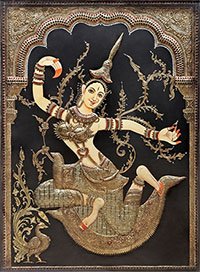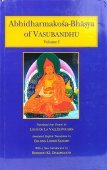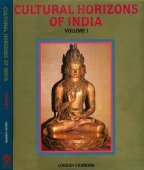Vinaya: 30 definitions
Introduction:
Vinaya means something in Buddhism, Pali, Hinduism, Sanskrit, Jainism, Prakrit, the history of ancient India, Marathi, Hindi. If you want to know the exact meaning, history, etymology or English translation of this term then check out the descriptions on this page. Add your comment or reference to a book if you want to contribute to this summary article.
Images (photo gallery)
In Hinduism
Purana and Itihasa (epic history)
Source: archive.org: Shiva Purana - English TranslationVinaya (विनय) or Vinayocita refers to “humble behaviour”, which is preferred above evil propensities (duśceṣṭita), according to the Śivapurāṇa 2.1.17. Accordingly, as Guṇanidhi, who was addicted to gambling (dyūta), was told by his mother as follows:—“[...] how is it that you do not feel ashamed of wickedness (durvṛtta)? Dear son, your maternal uncles too are matchless in learning (vidyā), conduct (śīla) and pedigree (kula) and other things. You are not afraid even of them. [...] See the Brahmin boys of your neighbourhood. Even in our house see the disciples of your father. How humbly do they behave (vinaya-ucita)? Dear son, if the king hears of your evil propensities (duśceṣṭita), he will cease to respect your father and may even suspend the regular maintenance allowance”.
Source: Cologne Digital Sanskrit Dictionaries: The Purana Index1a) Vinaya (विनय).—A son of Lajjā.*
- * Brahmāṇḍa-purāṇa II. 9. 61; Vāyu-purāṇa 10. 36.
1b) A son of Cancu.*
- * Brahmāṇḍa-purāṇa III. 63. 118.
1c) The discipline of mind and body important to a king; ill-disciplined kings have lost their empires; while disciplined kings leading a forest life attained kingdom through vinaya;1 of a Prince.2

The Purana (पुराण, purāṇas) refers to Sanskrit literature preserving ancient India’s vast cultural history, including historical legends, religious ceremonies, various arts and sciences. The eighteen mahapuranas total over 400,000 shlokas (metrical couplets) and date to at least several centuries BCE.
Ayurveda (science of life)
Source: gurumukhi.ru: Ayurveda glossary of termsVinaya (विनय):—Modesty or decency

Āyurveda (आयुर्वेद, ayurveda) is a branch of Indian science dealing with medicine, herbalism, taxology, anatomy, surgery, alchemy and related topics. Traditional practice of Āyurveda in ancient India dates back to at least the first millenium BC. Literature is commonly written in Sanskrit using various poetic metres.
Shaktism (Shakta philosophy)
Source: Google Books: Manthanabhairavatantram1) Vinaya (विनय) refers to “virtue”, according to the second recension of the Yogakhaṇḍa of the Manthānabhairavatantra, a vast sprawling work that belongs to a corpus of Tantric texts concerned with the worship of the goddess Kubjikā.—Accordingly, as the God (i.e., Bhairava) said to the Goddess (i.e., Khageśī), “[...] I will give up deceit and especially lust and anger. Tradition (anvaya) and virtue (vinaya)—this Kaula (teaching) has emerged today. I will observe all that. O Kaulinī, be gracious!”.
2) Vinayā (विनया) or Nādamaṅgalyā is the name of the Goddess associated with the direction North-east and the sacred seat of Nāda, according to the Manthānabhairavatantra.—Accordingly, “Nādamaṅgalyā (Vinayā) is in the north-east. She has the face of a bird and three eyes. She sits on a pig. She has ten arms and is very fierce. In the right hands she holds a sword, lance, bow, double-headed drum, and skeleton; in the left, a dagger, a skull (kādya), trident, fetter, and goad. She has matted hair and is the goddess who bestows boons in the north-east. Worshipped, there is success in whatever one desires. Full of the sixteen energies, she, the guardian of the door, is beautiful”.

Shakta (शाक्त, śākta) or Shaktism (śāktism) represents a tradition of Hinduism where the Goddess (Devi) is revered and worshipped. Shakta literature includes a range of scriptures, including various Agamas and Tantras, although its roots may be traced back to the Vedas.
Sports, Arts and Entertainment (wordly enjoyments)
Source: archive.org: Syainika Sastra of Rudradeva with English Translation (art)Vinaya (विनय) refers to a “modest woman”, according to the Śyainika-śāstra: a Sanskrit treatise dealing with the divisions and benefits of Hunting and Hawking, written by Rājā Rudradeva (or Candradeva) in possibly the 13th century.—Accordingly, “[...] It has been said that there are eighteen addictions. These are the outcome of the desire for earthly enjovments. [...] Wise men speak of that wife as a wife who has auspicious marks and who knows the fine arts, who is clever, who is loved by her husband, and who is young and modest (vayas-vinaya-sampannā). She is the chief instrument in attaining the three objects of life, and she is the distinguishing feature of domestic life. She looks after the children and the utensils and other articles of the household, and she charms the mind. [...]”.

This section covers the skills and profiencies of the Kalas (“performing arts”) and Shastras (“sciences”) involving ancient Indian traditions of sports, games, arts, entertainment, love-making and other means of wordly enjoyments. Traditionally these topics were dealt with in Sanskrit treatises explaing the philosophy and the justification of enjoying the pleasures of the senses.
In Buddhism
Theravada (major branch of Buddhism)
Source: Access to Insight: A Glossary of Pali and Buddhist TermsThe monastic discipline, spanning six volumes in printed text, whose rules and traditions define every aspect of the bhikkhus and bhikkhunis way of life. The essence of the rules for monastics is contained in the Patimokkha. The conjunction of the Dhamma with the Vinaya forms the core of the Buddhist religion: "Dhamma vinaya" - "the doctrine and discipline" - is the name the Buddha gave to the religion he founded.Source: Dhamma Dana: Pali English GlossaryM (Refusal, (morality). (Refusal of everything that is mean, disrespectful, careless, and propitious to sensuous delight and ignorance). Set of that which Buddha has taught in the field of conduct designed for bhikkhus.
The vinaya, whose patimokkha does constitute the core, is the first among the three portions of the tipitaka. The vinaya tends to be unfortunately often neglected. However it does deserve a great deal of consideration as it is the unavoidable foundation of the practice conducive to nibbana.
See also: The vinaya
Source: Dhamma Study: Cetasikasbook of Discipline for the monks
Theravāda is a major branch of Buddhism having the the Pali canon (tipitaka) as their canonical literature, which includes the vinaya-pitaka (monastic rules), the sutta-pitaka (Buddhist sermons) and the abhidhamma-pitaka (philosophy and psychology).
Mahayana (major branch of Buddhism)
Source: academia.edu: A Study and Translation of the GaganagañjaparipṛcchāVinaya (विनय) refers to “discipline”, according to the Gaganagañjaparipṛcchā: the eighth chapter of the Mahāsaṃnipāta (a collection of Mahāyāna Buddhist Sūtras).—Accordingly, “[...] The Bodhisattva Gaganagañja then sustained the jewel-canopy of ten thousand yojanas high over the Lord’s lion throne in the sky, joined the palms of his hands, saluted, and praised the Lord with these suitable verses: ‘[...] (6) Since the concept of mine (mamakāra) does not exist in the dharma of the Sugata, you neither depend (āśrita) nor hold (agrāha) on the dharma. But having known the discipline (vinaya) for all kinds of beings through conceptions (saṃkalpa) of the dharma, you always teach the supreme (annutara) dharma. [...]”.

Mahayana (महायान, mahāyāna) is a major branch of Buddhism focusing on the path of a Bodhisattva (spiritual aspirants/ enlightened beings). Extant literature is vast and primarely composed in the Sanskrit language. There are many sūtras of which some of the earliest are the various Prajñāpāramitā sūtras.
General definition (in Buddhism)
Source: Amaravati: Glossarythe monastic discipline, or the scriptural collection of its rules and commentaries.
In Jainism
General definition (in Jainism)
Source: archive.org: TrisastisalakapurusacaritraVinaya (विनय, “reverence”) represents a characteristic of six-fold inner penance: one of the two kinds of tapas, according to chapter 1.1 [ādīśvara-caritra] of Hemacandra’s 11th century Triṣaṣṭiśalākāpuruṣacaritra: an ancient Sanskrit epic poem narrating the history and legends of sixty-three illustrious persons in Jainism. Accordingly, in the sermon of Sūri Dharmaghoṣa:—“[...] that is called penance (tapas) that burns away karma. Outer penance is fasting, etc., and inner is confession and penance, etc. [...] Confession and penance (prayaścitta), service to others (vaiyāvṛtta), study of sacred texts (svādhyāya), reverence (vinaya), indifference to the body (vyutsarga), good meditation (śubhadhyāna) are the sixfold inner penance”.
Source: Encyclopedia of Jainism: Tattvartha Sutra 9: Influx of karmasVinaya (विनय).—How many types of reverence (vinaya) are there? It is of four types, namely:
- knowledge (jñāna),
- faith (darśana),
- conduct (cāritra),
- custom of homage (upacāra).
Vinaya (विनय) refers to “reverence to elders” and is one of the topics treated in the Ācārāṅga (Ācārāṃga), one of the Dvādaśāṅgī (twelve Aṅgas) of Jainism.—In a sequential point of view, Ācārāṃgastands first in Aṃgas. It is called as Prathama Aṃga as it is the vital Ācāra (conduct) of Śruta puruṣa (Monk / Saints). It is said that Ācārāṃga has 2 divisions (Śruta skaṇdhas), 25 chapters (adhyayanas), 85 topics (uddeśanakāla) and 85 sub topics (samuddeśanakālas). Ācārāṃga consists of 18000 verses. Topics include Vinaya (reverence to elders).

Jainism is an Indian religion of Dharma whose doctrine revolves around harmlessness (ahimsa) towards every living being. The two major branches (Digambara and Svetambara) of Jainism stimulate self-control (or, shramana, ‘self-reliance’) and spiritual development through a path of peace for the soul to progess to the ultimate goal.
India history and geography
Source: Cologne Digital Sanskrit Dictionaries: Indian Epigraphical GlossaryVinaya.—(IE 8-8; EI 30), fines. (EI 13), same as indriya-jaya. Note: vinaya is defined in the “Indian epigraphical glossary” as it can be found on ancient inscriptions commonly written in Sanskrit, Prakrit or Dravidian languages.

The history of India traces the identification of countries, villages, towns and other regions of India, as well as mythology, zoology, royal dynasties, rulers, tribes, local festivities and traditions and regional languages. Ancient India enjoyed religious freedom and encourages the path of Dharma, a concept common to Buddhism, Hinduism, and Jainism.
Languages of India and abroad
Pali-English dictionary
Source: BuddhaSasana: Concise Pali-English Dictionaryvinaya : (m.) discipline; the code of monastic discipline; removal.
Source: Sutta: The Pali Text Society's Pali-English DictionaryVinaya, (fr. vi+nī, cp. vineti) 1. driving out, abolishing destruction, removal Vin. I, 3 (asmi-mānassa), 235= III, 3 (akusalānaṃ dhammānaṃ vinayāya dhammaṃ desemi); S. I, 40; Sn. 921; A. I, 91 (kodha°, upanāha°); II, 34 (pipāsa°); IV, 15 (icchā°); V, 165 (id.); SnA 12; PvA. 114 (atthassa mūlaṃ nikati°). Often in phrase rāga°, dosa°, moha°, e.g. S. IV, 7 sq.; V, 137 sq. 241; A. IV, 175; Nett 22.—2. rule (in logic), way of saying or judging, sense, terminology (cp. iminā nayena) S. IV, 95 (ariyassa vinaye vuccati loko); A. I, 163 (ariyassa vinaye tevijjo one called a threefold wise in the nomenclature of the Buddhist); II, 166 (ariyassa v.); SnA 403.—3. norm of conduct, ethics, morality, good behaviour Sn. 916, 974; J. IV, 241 (=ācāra-vinaya C.); A. II, 112; III, 353 sq. (ariya-vinaye saddhā yassa patiṭṭhitā etc. faith established in Buddhist ethics).—4. code of ethics, monastic discipline, rule, rules of morality or of canon law. In this sense applied to the large collection of rules which grew up in the monastic life and habits of the bhikkhus and which form the ecclesiastical introduction to the “Dhamma, ” the “doctrine, ” or theoretical, philosophical part of the Buddhist Canon. The history & importance of the Vinaya Piṭaka will be dealt with under the title “Vinaya” in the Dictionary of Names. Only a few refs. must suffice here to give a general idea. See also under Dhamma C. and in detail Geiger, Dhamma pp. 55—58.—Often combined with dhamma: dhammato vinayato ca on the ground of Dh. and V. Vin. I, 337; cp. II. 247.—dhammo ca vinayo ca Vin. I, 356; II, 285, 302; or (as (Dvandva) dhammavinaya (i.e. the teaching of the Buddha in its completeness) D. I, 229; Vin. II, 237 sq.; M. I, 284; II, 181 sq.; A. I, 283; III, 297, 327; S. I, 9; III, 65; Ud. 53; VvA. 3. Often approaches the meaning of “Buddhist order, ” e.g. Vin. I, 69; D. I, 176; M. I, 68, 459, 480; III, 127; S. II, 120; A. I, 185; II, 123; V, 122.—See further Vin. II, 96 (vinaye cheko hoti); A. II, 168 (ayaṃ dhammo, ayaṃ v. idaṃ Satthu-sāsanaṃ); Vism. 522; VbhA. 273; KhA 106, 151; SnA 4, 195, 310.—a-vinaya one who sins against the V. (like a-dhamma one who neglects the Dh.) Vin. II, 295 sq.; III, 174; A. I, 18; V, 73 sq.—The division of the books of the Vinaya is given at DhsA. 18. Its character (as shown by its name) is given in the foll. verse at DhsA. 19: “(vividha-visesa-) nayattā vinayanato c’eva kāya-vācānaṃ vinayy’attha-vidūhi ayaṃ vinayo Vinayo ti akkhāto, ” i.e. “Because it shows precepts & principles, and governs both deed and word, therefore men call this scripture V. for so is V. interpreted” (Expos. I. 23).

Pali is the language of the Tipiṭaka, which is the sacred canon of Theravāda Buddhism and contains much of the Buddha’s speech. Closeley related to Sanskrit, both languages are used interchangeably between religions.
Marathi-English dictionary
Source: DDSA: The Molesworth Marathi and English Dictionaryvinaya (विनय).—m (S) Humility, lowliness, meekness: also condescension, affability, graciousness, courteousness or mildness towards inferiors.
Source: DDSA: The Aryabhusan school dictionary, Marathi-Englishvinaya (विनय).—m Humility. Condescension.
Marathi is an Indo-European language having over 70 million native speakers people in (predominantly) Maharashtra India. Marathi, like many other Indo-Aryan languages, evolved from early forms of Prakrit, which itself is a subset of Sanskrit, one of the most ancient languages of the world.
Sanskrit dictionary
Source: DDSA: The practical Sanskrit-English dictionaryVinaya (विनय).—a.
1) Cast, thrown.
2) Secret.
3) Ill-behaved.
-yaḥ 1 Guidance, discipline, instruction (in one's duties), moral training; सर्वक्षत्त्रनिवर्हणस्य विनयं कुर्युः कथं क्षत्त्रियाः (sarvakṣattranivarhaṇasya vinayaṃ kuryuḥ kathaṃ kṣattriyāḥ) Mv.3.37; प्रजानां विनयाधानात् (prajānāṃ vinayādhānāt) R.1.24; Mālatīmādhava (Bombay) 1.5; विनया- धिकारिकं प्रथमाधिकरणम् (vinayā- dhikārikaṃ prathamādhikaraṇam) Kau. A.
2) Sense of propriety, decorum, decency; अनुयास्यन् मुनितनयां सहसा विनयेन वारित- प्रसरः (anuyāsyan munitanayāṃ sahasā vinayena vārita- prasaraḥ) Ś.1.28.
3) Polite conduct, gentleman-like bearing, good breeding or manners; गुणैश्च तैस्तैर्विनयप्रधानैः (guṇaiśca taistairvinayapradhānaiḥ) R.6.79; Mālatīmādhava (Bombay) 1.18.
4) Modesty, humility; सुष्ठु शोभसे आर्यपुत्र एतेन विनयमाहात्म्येन (suṣṭhu śobhase āryaputra etena vinayamāhātmyena) Uttararāmacarita 1; विद्या ददाति विनयम् (vidyā dadāti vinayam); तथापि नीचैर्विनयाददृश्यत (tathāpi nīcairvinayādadṛśyata) R.3.34;1.71 (where Malli. renders vinaya by indriyajaya or restraint of passions, unnecessarily in our opinion).
5) Reverence, courtesy, obeisance.
6) Conduct in general.
7) Drawing off, taking away, removing; उत्तरीयविनयात् त्रपमाणा (uttarīyavinayāt trapamāṇā) Śiśupālavadha 1.42.
8) A man who has subdued his senses.
9) A trader, merchant.
1) Chastisement (daṇḍa); शीलवृत्तमविज्ञाय धास्यामि विनयं परम् (śīlavṛttamavijñāya dhāsyāmi vinayaṃ param) Mahābhārata (Bombay) 3. 36.19.
11) An office, business; विफलविनययत्नाः कामिनीनां वयस्याः (viphalavinayayatnāḥ kāminīnāṃ vayasyāḥ) Śiśupālavadha 11.36.
Source: Cologne Digital Sanskrit Dictionaries: Edgerton Buddhist Hybrid Sanskrit DictionaryVinaya (विनय).—m. (= Pali id.), (book of) discipline, one of the sections of the canon: Mahāvyutpatti 1414 (after sūtram, abhi- dharmaḥ); sūtra-vinayābhidharmeṇa Laṅkāvatāra-sūtra 290.8; Vinaye, in the (text of the) V., Karmavibhaṅga (and Karmavibhaṅgopadeśa) 59.18; 60.9; 71.10; 158.17. In Śikṣāsamuccaya 190.4, kim-ākāraṃ śrutaṃ bodhisattva-vinaye praśastaṃ, Bendall in text and translation(s) understands bodhi- sattvavinaya as name of a work, but I believe it means merely in the training of Bodhisattvas; there follows immediately a citation from the Akṣayamati-sūtra. See next items.
Source: Cologne Digital Sanskrit Dictionaries: Shabda-Sagara Sanskrit-English DictionaryVinaya (विनय).—m.
(-yaḥ) 1. Modesty, affability, humility, mildness. 2. Reverence, obeisance. 3. Decorum, decency, propriety of conduct or behaviour. 4. Training, discipline. 5. Subduing the senses. 6. A man of subdued senses. 7. A merchant. f.
(-yā) 1. Secret. 2. Cast, thrown. 3. A plant. (Sida cordifolia, &c.) E. vi before, nī to obtain or guide, aff. ac .
Source: Cologne Digital Sanskrit Dictionaries: Benfey Sanskrit-English DictionaryVinaya (विनय).—i. e. vi-nī + a, m. 1. Training, discipline, [Raghuvaṃśa, (ed. Stenzler.)] 10, 80. 2. Good behaviour, [Pañcatantra] iii. [distich] 122. 3. Behaviour, [Uttara Rāmacarita, 2. ed. Calc., 1862.] 109, 6. 4. Reverence, [Lassen, Anthologia Sanskritica.] 2. ed. 35, 11. 5. Modesty, [Pañcatantra] i. [distich] 12.
Source: Cologne Digital Sanskrit Dictionaries: Cappeller Sanskrit-English DictionaryVinaya (विनय).—[adjective] removing. [masculine] removal, withdrawal; training, breeding, discipline, good manners, modesty, courtesy.
Source: Cologne Digital Sanskrit Dictionaries: Monier-Williams Sanskrit-English Dictionary1) Vinaya (विनय):—[=vi-naya] 1. vi-naya (said to be artificially formed [from] vi nṛ; for 2. See under vi-√nī) [Nominal verb] [Parasmaipada] yati (with prefix 3. vi; [indeclinable participle] vi-vinayya), [Pāṇini 1-4, 1], [vArttika] 7, [Patañjali]
2) [=vi-naya] [from vi-nī] 2. vi-naya mfn. (for 1. See p.969) leading away or asunder, separating, [Ṛg-veda ii, 24, 9]
3) [v.s. ...] cast, thrown, [cf. Lexicographers, esp. such as amarasiṃha, halāyudha, hemacandra, etc.]
4) [v.s. ...] secret, [cf. Lexicographers, esp. such as amarasiṃha, halāyudha, hemacandra, etc.]
5) [v.s. ...] m. taking away, removal, withdrawal, [Śiśupāla-vadha x, 42]
6) [v.s. ...] leading, guidance, training ([especially] moral tr°), education, discipline, control, [Mahābhārata; Kāvya literature] etc.
7) [v.s. ...] (with Buddhists) the rules of discipline for monks, [Monier-Williams’ Buddhism 55 etc.]
8) [v.s. ...] good breeding, propriety of conduct, decency, modesty, mildness, [ib.] (in the Purāṇas sometimes personified as son of Kriyā or of Lajjā)
9) [v.s. ...] an office, business, [Śiśupāla-vadha xi, 36]
10) [v.s. ...] Name of a son of Sudyumna, [Mārkaṇḍeya-purāṇa]
11) [v.s. ...] a man of subdued senses, [cf. Lexicographers, esp. such as amarasiṃha, halāyudha, hemacandra, etc.]
12) [v.s. ...] a merchant, trader, [cf. Lexicographers, esp. such as amarasiṃha, halāyudha, hemacandra, etc.]
13) Vinayā (विनया):—[=vi-nayā] [from vi-naya > vi-nī] f. Sida Cordifolia, [cf. Lexicographers, esp. such as amarasiṃha, halāyudha, hemacandra, etc.]
Source: Cologne Digital Sanskrit Dictionaries: Yates Sanskrit-English DictionaryVinaya (विनय):—[vi-naya] (yaḥ) 1. m. Modesty; affability, mildness, decorum, obeisance. f. A plant Sida cordifolia.
Source: DDSA: Paia-sadda-mahannavo; a comprehensive Prakrit Hindi dictionary (S)Vinaya (विनय) in the Sanskrit language is related to the Prakrit word: Viṇaya.
[Sanskrit to German]
Sanskrit, also spelled संस्कृतम् (saṃskṛtam), is an ancient language of India commonly seen as the grandmother of the Indo-European language family (even English!). Closely allied with Prakrit and Pali, Sanskrit is more exhaustive in both grammar and terms and has the most extensive collection of literature in the world, greatly surpassing its sister-languages Greek and Latin.
Hindi dictionary
Source: DDSA: A practical Hindi-English dictionaryVinaya (विनय) [Also spelled vinay]:—(nf) modesty, politeness, humbleness, humility; ~[śīla] humble, modest, polite; ~[śīlatā] humbleness, modesty, politeness, humility.
...
Prakrit-English dictionary
Source: DDSA: Paia-sadda-mahannavo; a comprehensive Prakrit Hindi dictionary1) Viṇaya (विणय) in the Prakrit language is related to the Sanskrit word: Vinaya.
2) Viṇaya (विणय) also relates to the Sanskrit word: Vinata.
3) Viṇayā (विणया) also relates to the Sanskrit word: Vinatā.
Prakrit is an ancient language closely associated with both Pali and Sanskrit. Jain literature is often composed in this language or sub-dialects, such as the Agamas and their commentaries which are written in Ardhamagadhi and Maharashtri Prakrit. The earliest extant texts can be dated to as early as the 4th century BCE although core portions might be older.
Kannada-English dictionary
Source: Alar: Kannada-English corpusVinaya (ವಿನಯ):—
1) [noun] the quality of being good, kind; goodness; kindness; generosity; benevolence 2) courteous behavior; gracious politeness; courtesy.
2) [noun] propriety of conduct and speech; proper behavior; decency.
3) [noun] guidance given for behaving properly or in a graceious manner.
4) [noun] a written plea, appealing for some help or sympathy; a petition.
5) [noun] polite, courteous speech.
6) [noun] a fine imposed as a punishment.
Kannada is a Dravidian language (as opposed to the Indo-European language family) mainly spoken in the southwestern region of India.
See also (Relevant definitions)
Starts with (+125): Vinaya School, Vinaya Vagga, Vinaya-campannatai, Vinayabhaj, Vinayacampattu, Vinayacandra, Vinayachandra, Vinayadatta, Vinayadeva, Vinayadevasuri, Vinayadhara, Vinayadhara Sutta, Vinayadharasobhana Sutta, Vinayadi, Vinayadidhara, Vinayaditya, Vinayadityapura, Vinayaga, Vinayagandhi, Vinayaganthipada.
Ends with (+18): Abhivinaya, Aghatapativinaya, Amudhavinaya, Anunaya-vinaya, Avinaya, Bhikshunivinaya, Caritravinaya, Charitravinaya, Darshanavinaya, Dhammavinaya, Dharmavinaya, Durvinaya, Gihivinaya, Hatavinaya, Icchavinaya, Jivavinaya, Jnanavinaya, Kilesavinaya, Kivinaya, Kodhavinaya.
Full-text (+1784): Tipitaka, Vinayabhaj, Vinayapramathin, Vinayavac, Vinayagrahin, Vinata, Vinayapitaka, Vinayastha, Vinayadhara, Vinayavastu, Vinayavati, Durvinaya, Savinayam, Vinayakarman, Vinayavalli, Vinayavibhanga, Vinayapattra, Vinayasundara, Vinayajyotis, Vinayasvamini.
Relevant text
Search found 173 books and stories containing Vinaya, Vi-naya, Vinayā, Vi-nayā, Viṇaya, Viṇayā; (plurals include: Vinayas, nayas, Vinayās, nayās, Viṇayas, Viṇayās). You can also click to the full overview containing English textual excerpts. Below are direct links for the most relevant articles:
Bhesajjakkhandhaka (Chapter on Medicine) (by Hin-tak Sik)
(b) The Skandhaka < [Chapter 2 - Background Information]
Seven-day Medicines (b): Animal Fats (Vasā) < [Chapter 4 - Medicinal Substances in the Chapter on Medicine]
Chapter Summary < [Chapter 4 - Medicinal Substances in the Chapter on Medicine]
Maha Prajnaparamita Sastra (by Gelongma Karma Migme Chödrön)
Appendix 2 - The journey of the Buddha to southern India and Koṭikarṇa < [Chapter XV - The Arrival of the Bodhisattvas of the Ten Directions]
Seventh aṅga (member): Avadāna < [Part 2 - Hearing the twelve-membered speech of the Buddha]
Appendix 1 - The story of the vaiśya Meṇḍaka < [Chapter XXVI - Exertion]
The Great Chronicle of Buddhas (by Ven. Mingun Sayadaw)
Part 29 - The Discourse at Bhoga on the Four Great Authorities (Mahāpadesas) < [Chapter 40 - The Buddha Declared the Seven Factors of Non-Decline for Rulers]
Biography (35): Upāli Mahāthera < [Chapter 43 - Forty-one Arahat-Mahatheras and their Respective Etadagga titles]
Part 4 - Righteous (Dhammavādi) and Unrighteous (Adhammavādi) < [Chapter 28 - The Buddha’s Tenth Vassa at Pālileyyaka Forest]
Mahayana Mahaparinirvana Sutra
Chapter IX - On Wrong and Right < [Section One]
Chapter V - On the Adamantine Body < [Section One]
Chapter XIII - On Letters < [Section Two]
Dipavamsa (study) (by Sibani Barman)
Chapter 2b - The first Buddhist Council
Chapter 2a - Accounts of Indo-Ceylonese Saddhamma-Saṅgha
Bhakti-rasamrta-sindhu (by Śrīla Rūpa Gosvāmī)
Verse 2.4.195 < [Part 4 - Transient Ecstatic Disturbances (vyābhicāri-bhāva)]
Verse 2.1.141 < [Part 1 - Ecstatic Excitants (vibhāva)]
Verse 2.1.234 < [Part 1 - Ecstatic Excitants (vibhāva)]
Related products



